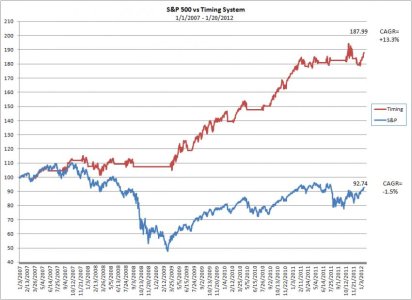SkyPilot, I'm guessing you're not getting it. Let me provide a theoretical example:
Mr. BuyN-Hold buys 1,000 shares of the market at $100 a share.
His account value is $100 X 1,000 shares = $100,000.
The market goes up 20%.
His account value is $120 X 1,000 shares = $120,000.
So far so good...
Now the market goes down 20%.
His shares are only worth $96.
Account value is $96 X 1,000 shares = $96,000
Now the market goes back up 20%.
His shares are now worth $115.20.
Account value is $115.20 X 1,000 shares = 115,200
Now the market goes back down 20%.
His shares are now worth $92.16.
Account value is $92.16 X 1,000 shares =
$92,160.
Does the above make sense to you?
Now let's look at the exact same theoretical market conditions, except with someone who sells high and buys low:
Mr. ExpertTimer buys 1,000 shares of the market at $100 a share.
His account value is $100 X 1,000 shares = $100,000.
The market goes up 20%.
His account value is $120 X 1,000 shares = $120,000.
So far he's got the same results as MrBuyN-Hold...
But now he
sells at this theoretical high!
He puts the $120,000 into the bank, under the matress, in a coffee can, whatever, and earns zero percent interest.
While he's sitting in cash, the market goes down 20%.
Now the same shares can be purchased at $96.
He pulls the $120,000 out of the bank, and
buys low!
He buys 1,250 shares of the market at $96.
Account value is $96 X 1,250 shares = $120,000.
Now the market goes back up 20%.
His shares are now worth $115.20.
Account value is $115.20 X 1,250 shares = $144,000.
Since he's timing the market,
he gets out at the top again.
$144,000 goes into the bank or under the matress...
... until the market bottoms once again!
So the market goes back down 20% while he's sitting in cash.
Now it's time to
buy low!
He can now purchase shares at $92.16.
He purchases 1562.5 shares at $92.16
Account value is $92.16 X 1,562.5 shares =
$144,000.
I could go on and on with this, but this should provide a good illustration. The market performed the same, it was the timing that made the difference.
Mr. BuyN-Hold account value =
$92,160
Mr. ExpertTimer account value
= $144,000
That's 56% more money over buy & hold.
Hope that helps!
JR


